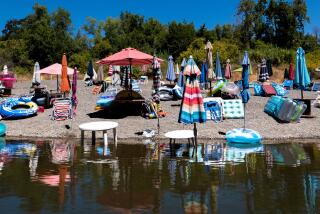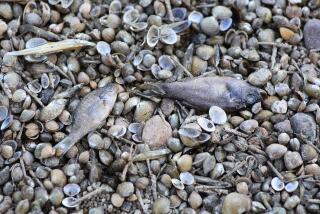Guerneville Rises to a River’s Challenge
- Share via
GUERNEVILLE, Calif. — When the big storm clouds park over the wine country and the rain-swollen Russian River tops its banks, folks here shrug their shoulders, pull on rubber boots and begin what’s become a time-honored ritual.
Belongings are lugged to the second floor. Sandbags sprout on door stoops. Citizens swarm Safeway for provisions. Merchants raise clothing racks on milk crates or pack up everything in getaway trucks.
“We’ve got it down to a science,” said Audrey McDonald, whose father owns River Auto Parts, one of Guerneville’s more flood-prone businesses. “I rent the trucks. We move the stock. The water recedes, we clean up and we’re back in business within a couple days.”
In a region that has long been California’s most fickle flood plain, this is simply life on the river.
The news media may shout about disaster and damage estimates might soar, but gritty little Guerneville and its sister communities along the Russian River’s redwood-studded length somehow manage to rebound, to the continued amazement of the outside world. Rain is expected to return this weekend, and residents are ready.
Theirs is a particularly California conundrum. Like wildfires in Topanga and earthquakes throughout the state, flooding in Sonoma County is an unwanted visitor. But the bad days simply can’t overshadow the good: the languid beauty of the forests, autumn gold in the vineyards, the Russian River’s pond-like bends.
“In L.A. you’ve got earthquakes and mudslides, in Kansas you’ve got tornadoes,” said George Weaver, the auto parts store manager. “Basically, everywhere you live something bad can happen.”
But disaster strikes often, roughly once a decade, along the western gorge of the Russian River.
One can talk to just about any longtime local and get a history lesson on high water.
There was the big one at Christmas 1955 and there were the double floods of ’95. The river visited swaths of Guerneville and neighboring Rio Nido and Monte Rio in 1964, 1967, 1982 and 1997.
The granddaddy of them all -- at least in living memory -- came in 1986, when the river jumped 16 feet above its banks and even the highest spot in Guerneville’s tiny grid of downtown streets saw 18 inches of muddy, olive-brown floodwater. Scores of houses and other buildings were inundated.
Guerneville’s 2,400 residents got reacquainted with old man river’s cranky nature when monsoon-like storms hit during the last weekend of 2005, dropping nearly a foot of rain on parts of Sonoma County in barely 48 hours.
New Orleans this was not. Cresting about 7 feet lower than it did during the 1986 flood, the Russian River and its tributaries didn’t get close to the doorsteps of most businesses along Main Street. Peripheral streets saw flooding up to a few feet.
At a local bar, Wild Jane’s, owner Dave Roberts said an afternoon crowd gathered New Year’s Eve even as the river and nearby Fife Creek swelled.
“We just kept drinking,” Roberts said. “It took another 45 minutes until the water was above our ankles, then we figured it was time to shut down.”
The worst damage hit the usual low-lying spots. There, the water rose as high as a man’s head.
But across Sonoma County, 44 residences were left uninhabitable and officials estimate that the storm dished up $103 million worth of damage, most of it along the Russian River. Gov. Arnold Schwarzenegger declared 23 counties disaster areas.
In Guerneville, long-timers handled the aftermath with studied nonchalance.
To Bill Guerne, great-grandson of the town’s founder, “this wasn’t even a flood. Low-lying places is all it got.”
Guerne’s ancestor arrived in the 1860s to log the steep hillsides of west Sonoma County. Six generations of the family have lived along the Russian River.
A 59-year-old building contractor with grandkids of his own, Guerne best remembers the 1955 flood. He was 9, and he whiled away the disaster racing his pals on Main Street -- in rowboats.
“When you buy here, it’s like playing Russian roulette,” he said with a chuckle.
But to the outside world, the perception is that “we’ve been knocked down like New Orleans,” griped Arrow Olesky, owner of Seconds First, a Main Street second-hand store.
As do many other locals, she blames the media. Any time the Russian River rises, TV news trucks show up to interview the first victims, usually residents in vulnerable trailer parks with a tale of woe.
This time the water didn’t even get close to Main Street merchants, “but people think we’ve been wiped out,” Olesky said. “This will cut into business for the rest of the year.”
A popular summer resort for the first half of the 20th century, Guerneville began to evolve into a year-round community in the 1970s, with the migration of gay sun worshipers and urban expatriates.
The influx produced many more potential victims.
Most folks say the big flood of ’86 was the real eye-opener for new arrivals. Some fled, but plenty stuck it out. With the aid of federal disaster assistance, businesses rebuilt and residents made the first efforts to elevate their homes.
Today, the county doesn’t allow any construction unless it’s elevated above the 100-year flood mark. Scores of older houses have been elevated, set up on big concrete piers or wood posts, with living quarters on the second floor, big garages at ground level.
Folks who don’t take preventive action are “sticking their heads in the sand,” said David Robertson, Sonoma County’s deputy public works director.
“If you choose to live in an environment that has these fluctuations, you have to choose to be responsible for your actions,” said Robertson, who grew up in Guerneville. “The government shouldn’t have to come in and save you or bail you out with money all the time.”
There’s been no word whether the federal government will provide disaster assistance. Buying flood insurance is de rigueur hereabout, so the hardest hit typically have a financial lifeline.
But even for a few veterans, high water is no picnic.
Dick and Midge Holling expected no more than a swamped parking lot at their Rio Nido Bar, but water flowed right up to the redwood bar top, soaking drywall and tossing around anything in the way.
In 1986, they had to be plucked from the roof of their place. But this latest and lighter inundation still creates a mountain of hassles -- cleanup, tallying damage -- while they’re trying to sell the bar and retire.
“It’s less than ‘86, but it’s still hard to take,” said Midge Holling, lighting a cigarette. “If they had dredged the river, we wouldn’t be in this situation.”
She’s not holding her breath. With the Russian River’s native steelhead and a pair of salmon species on the endangered list, government officials don’t consider dredging an option.
Two upriver dams control only 18% of the flow, meaning the river is largely unchecked in big storms. New dams and beefy river levees are maligned by experts as fiscally and environmentally impractical. Other brainstorm solutions -- Guerne likes the notion of building a massive upriver diversion tunnel and channel -- are deemed too expensive.
Just about everyone here lays part of the blame on upstream subdivisions where soil that once absorbed water is now paved over.
Carl Combs tried to fight it. The 1986 flood covered his Rio Nido home and half a dozen rental units he owns. Combs, a psychotherapist, lashed his Steinway piano to a wall to keep it from floating away.
Within months, Combs said, he joined a homeowners’ lawsuit to block upstream development in Sonoma County and several of its cities. Ultimately, he said, the state Supreme Court rejected the legal challenge.
But he’s still here.
Meanwhile, the Russian River defies taming, reminding old folks of nature’s power, slapping newcomers with an unwelcome greeting.
Just six weeks after they purchased the 36-unit Brookside Lodge, Naveed Haneef and Karen O’Brien watched churning floodwater push through locked doors and toss around chairs and TVs.
The couple, high-tech workers who liquidated everything to move 60 miles north from San Francisco, were greeted by the pluck that comes along this riverfront.
Neighbors they didn’t even know called to help. A contractor’s crew was already rebuilding two days after the water loosened its grip.
“It’s not the end of the world. It’s a setback,” said O’Brien. “We knew this was going to be a challenge. But we’re up for it.”
More to Read
Sign up for Essential California
The most important California stories and recommendations in your inbox every morning.
You may occasionally receive promotional content from the Los Angeles Times.










